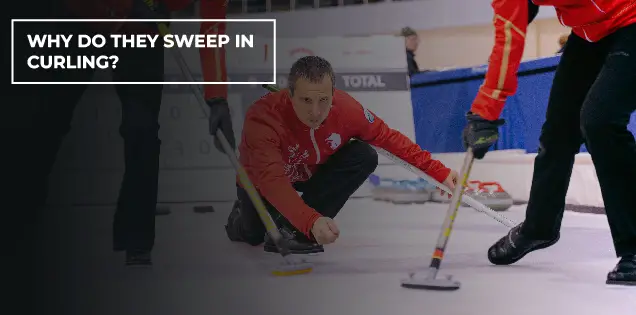So, why do they sweep in curling? An in-depth investigation of almost any topic almost always increases that topic’s interest level. This case is undeniably the situation with curling. This sport is puzzling to many people and, regrettably, often the punch line of jokes. However, it is a sport with a long history. It emphasizes excellent sportsmanship, strategy, athleticism, and lots of science!
In this article, we’ll look at why they sweep at curling.
So, let’s get right into it!
Why Do They Sweep the Ice in Curling?
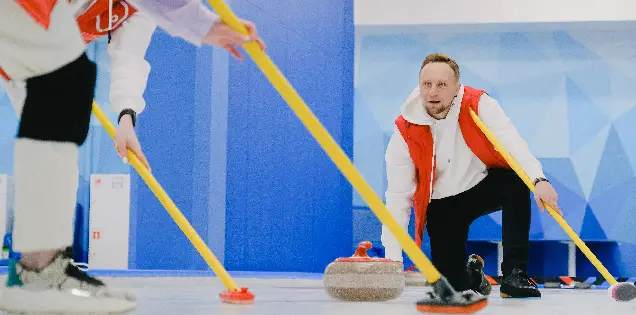
Sweeping relies on a fundamental idea that is surprisingly easy to explain. Sweeping produces heat, which breaks the ice, generating a tiny layer of water on which the big granite stone slides more freely. This speed is due to the reduced friction between the stone and the water compared to the friction between the stone and the ice.
You can increase the stone’s speed and distance by clearing the way. Additionally, it serves another purpose. The amount to which a stone “curls” (or travels in a certain direction) may be affected by sweeping.
This curling is when science begins to become tricky. So why does the stone curl? That’s because people release the stone with a fraction of a turn in either direction (clockwise or counterclockwise). The stone’s front rotates in one direction while its back rotates in the other.
However, the stone is slanted ever-so-slightly forward, so the downward pressure melts more ice in the front than in the back. As a result, a stone rolling in a clockwise direction will curve to the right, as this route offers the least friction. Stones are less likely to curl when swept more effectively because less friction is present between the ice and the stone.
You haven’t heard the last of it yet. Spraying water upon curling ice freezes it into small bumps, giving the ice a “pebbled” texture. Since the stones only touch the bumps’ flat surfaces, friction gets greatly reduced, and the stones may easily glide past one another.
Curlers need to examine the level of pebbling on a given sheet of ice to predict how it will affect the speed of the stone and the effectiveness of sweeping.
Does Sweeping in Curling Slow It Down?
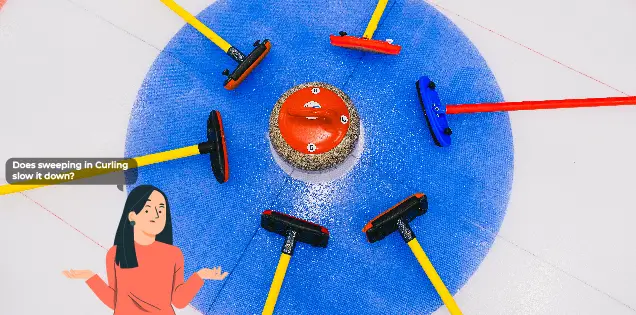
No, it does not.
Sweeping has many purposes:
- It increases the stone’s speed.
- It cleans the surface that lies under the stone.
- It reduces the amount of curl.
Therefore, brushing the stone does not make it move slowly; rather, the stone moves quicker.
The widespread notion is that the ice is not smooth but rather pebbled. This notion arises from the observation that spraying a fine mist on the ice forms tiny ice droplets when the mist freezes.
The Denver Curling Club’s ice technologist, Brian Brown, describes the ice surface of the club as “like the skin of an orange.” This surface helps the stone move quicker since there is less friction between the stone and the water droplets’ tops than on smooth ice.
Sweeping clears the route of the stone of any debris that may be in its way. However, more crucially, the friction created between the broom and the surface causes the ice to melt, producing a thin layer of water that makes it easier for the stone to glide. It also reduces the quantity of curl, which is due to the same cause.
What Is on the Bottom of a Curling Broom?
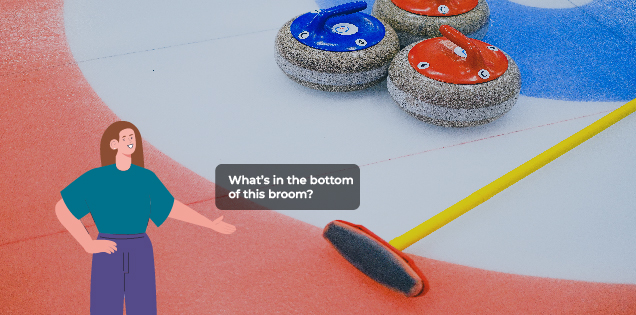
It depends on the broom.
The first reference to curling emerged from Scotland in the 16th century. Players then swept the ice using ordinary household brooms made from corn husks. The brooms used for curling have come a long way from when you could purchase one at Walmart and use it to sweep your kitchen floor.
Broom handles can be of carbon fiber or fiberglass. Brooms come in various flexibilities, and you can even equip them with rigid or gimbaled heads to which a brush made of various materials is connected.
Some brushes comprise horse or hog hair. However, the ones that are now the most popular comprise different mixes of synthetic materials such as nylon, polyester, or polyurethane. Horse and hog hair brushes are also available.
As a result of “brush gate,” a scandal that broke out in 2015 when people figured out that some brushes offered a competitive edge, competitions nowadays often require the use of standardized brushes.
It should come as no surprise that the effectiveness of the sweeping is dependent not only on the brush but also on the sweeper. The ability to do physically demanding tasks is a must in this context. Sweeping at a rapid pace is difficult and needs the sweeper to not only be in high physical condition but also be able to navigate on the ice to be successful properly.
What Happens if a Sweeper Touches the Stone in Curling?
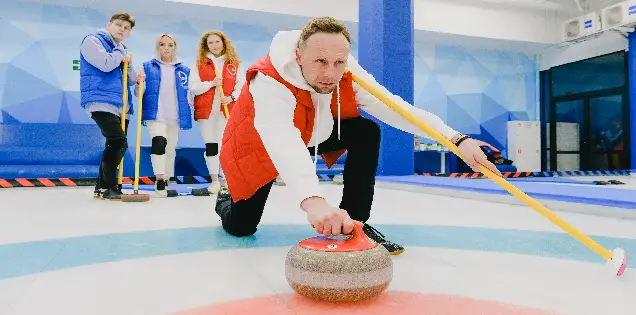
The act of coming into contact with the ball is “Burning a Stone.” The opponent team takes a call on what to do with the stone.
After reaching the hog line, the opponent team can decide what to do with the stone if a curler ‘burns a stone.’ Since curling is a game played with friendship and respect, the skip may choose to let the stone remain in its current position. In most cases, the stone moves at a slow speed. Hence, the presence of the foreign item will not possibly affect the stone’s trajectory.
The stone is considered burnt if any portion of the throwing team’s broom, clothing pieces, or any other object from the outside world comes into contact with the stone as it moves down the ice. This rule is because everything, regardless of how huge or little, comes into contact with the stone and has the potential to change its course. As a result, the stone gets moved many times until it settles into its permanent location.
No monitor or other technology can identify whether a stone has been burnt, in contrast to hog line infractions. However, due to this technological inability, it is reasonable to expect curlers to be truthful when they burn a stone.
What Are the Sweeping Rules in Curling?
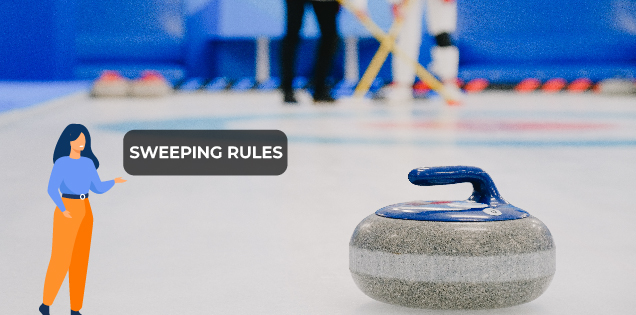
In sweeping, there aren’t only rules. Rather, there are theories and terms as well. We have discussed all the sweeping rules and regulations in curling below:
Theories of Sweeping
It takes a curling stone a longer time to slow down after a sweeper has swept it, and it causes the stone to curl less as a result. This pace results in the stone traveling in a more straight line and going a greater distance. Two theories attempt to explain why sweeping works as it does. However, empirical evidence has not validated these theories. Both of these theories are:
- The first theory proposes that the sweeper can melt the pebble by sweeping the ice, enabling the stone to move in a more direct path and for a greater distance.
- The second theory proposes that by skimming the ice, the pebble is polished, which in turn allows the stone to move in a more direct path and for a greater distance.
Reasons to Sweep
The sweepers in a game of curling are required to sweep the stone for two primary reasons. These are:
- To maintain the stone’s position on the correct line so it may go to the location you want it to.
- To make the stone go farther for it to reach the location you want it to go.
Sweeping for Line
When the sweepers are sweeping for line, they are sweeping in such a way that the stone will curl less and move in a more straight path due to their efforts. For example, when a team is attempting to lay a stone behind a guard or when a team has to strike a stone in a very specific spot, that team needs to do this sort of sweeping.
Sweeping for Weight
When the sweepers are sweeping for weight, they are sweeping to increase the distance the stone travels. Sometimes the stone will be light, and they need to sweep to ensure it can move the necessary distance. On other occasions, the weight may be great, but it may take a few tweaks to the sweeping motions to halt in the appropriate spot.
Note that sweepers cannot cause a stone to speed faster, but they may lessen the pace at which the stone slows down.
Defensive Sweeping
Now that you know how a team may sweep their curling stones, we will teach you where and when your opponent can sweep your stones out of play in curling. When playing defense, the objective of sweeping is to eliminate an opponent’s stone from the game or, at the very least, to move it farther away from the button.
A curler on the ice will do defensive sweeping exactly the same way they would perform any other kind of sweeping. After one of your team’s stones has crossed the tee line, a member of the opposing team, often the skip, will be able to sweep one of your team’s stones. When the stone is traveling at a decent speed, defensive sweeping has a chance of knocking it out of play and placing it in the off-limits area.
You can attempt to sweep your opponent’s stones out of play the same way they may try to sweep them out of play. However, this is only possible if the stone in question crosses the tee line.
Defensive Sweeping Rules
There are two primary guidelines to follow while sweeping the defense defensively. They are:
- When your stone starts to go over the tee line, an opponent has the opportunity to sweep it away from you.
- As a defensive strategy, a single player on the opposing side is permitted to sweep the stones.
Defensive Sweeping Past the Tee Line
Your opponent is permitted to sweep as soon as one of their stones starts to cross the tee line in the game you are playing. Your opponent can sweep the stone until it stops moving, reaches the sideline, or completely crosses the backline. This rule is true even if just a fraction of the stone or the whole stone is beyond the tee line.
One Person Sweeps Defensively
When your stone begins to travel over the tee line, just one curler from the opponent’s side is permitted to sweep the stone to stop it from going over the line. However, suppose a sweeper may sweep many stones strategically. In that case, an opponent can select 1 player for each stone to do the defensive sweep.
As a result, if you can sweep two of your stones defensively, the opponent half can have two defensive sweepers, provided they are sweeping different stones. This rule is true, although both of your stones have the potential to be swept defensively. This rule applies to three or more stones that have the possibility of being swept as a defensive move.
Final Words – Why Do They Sweep in Curling?
So, that was all for today. We hope we have briefly answered all your doubts regarding sweeping in curling.
Read Also: Why Do Electrical Plugs Have Holes?
